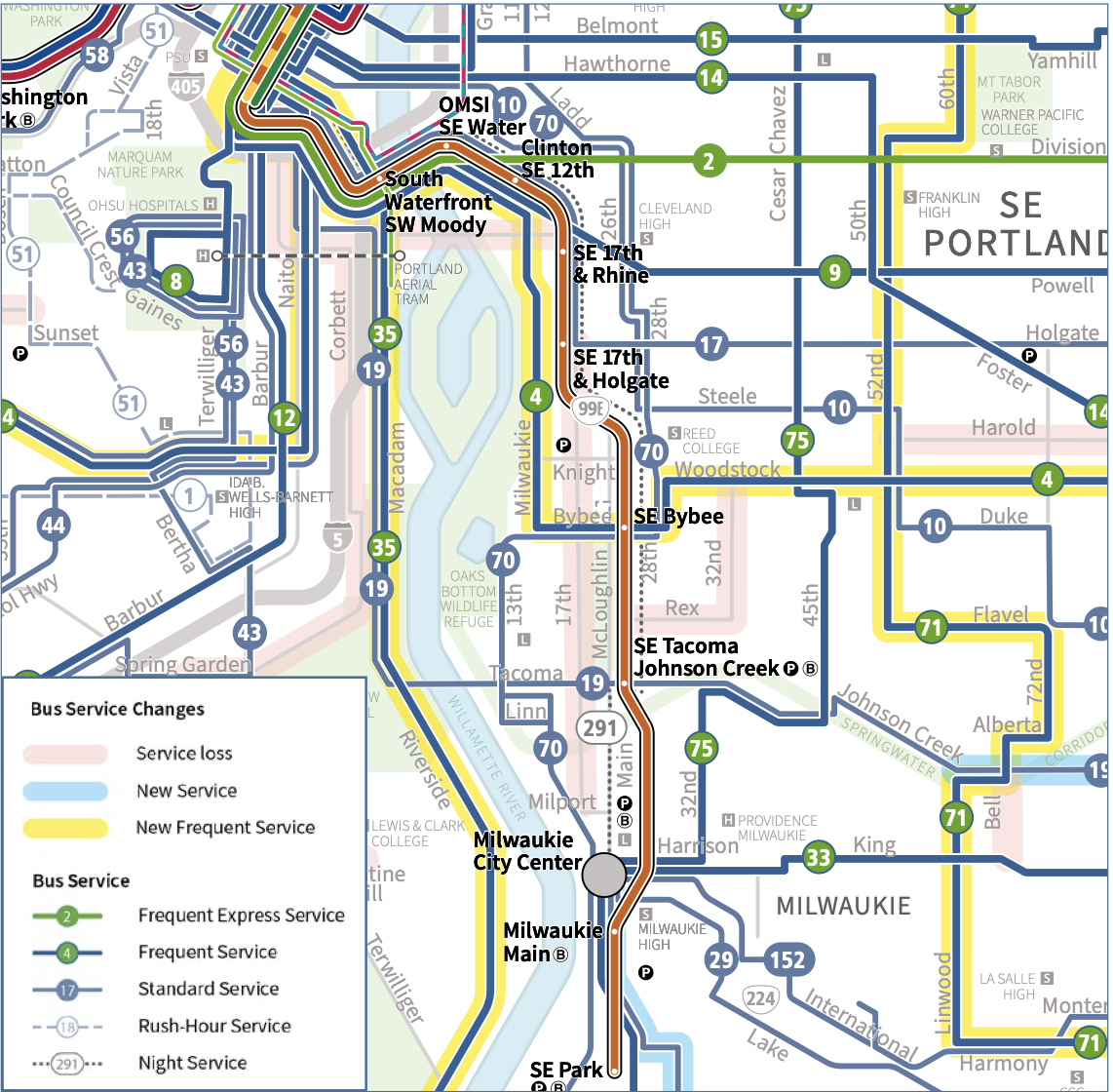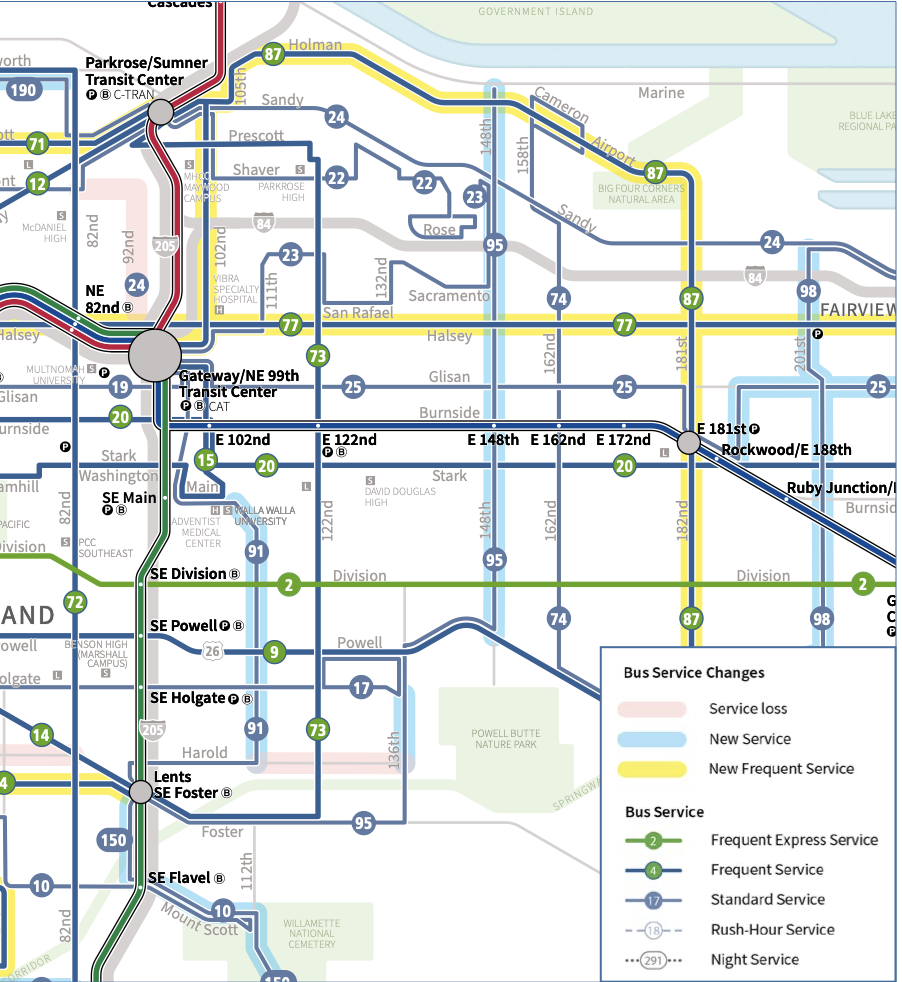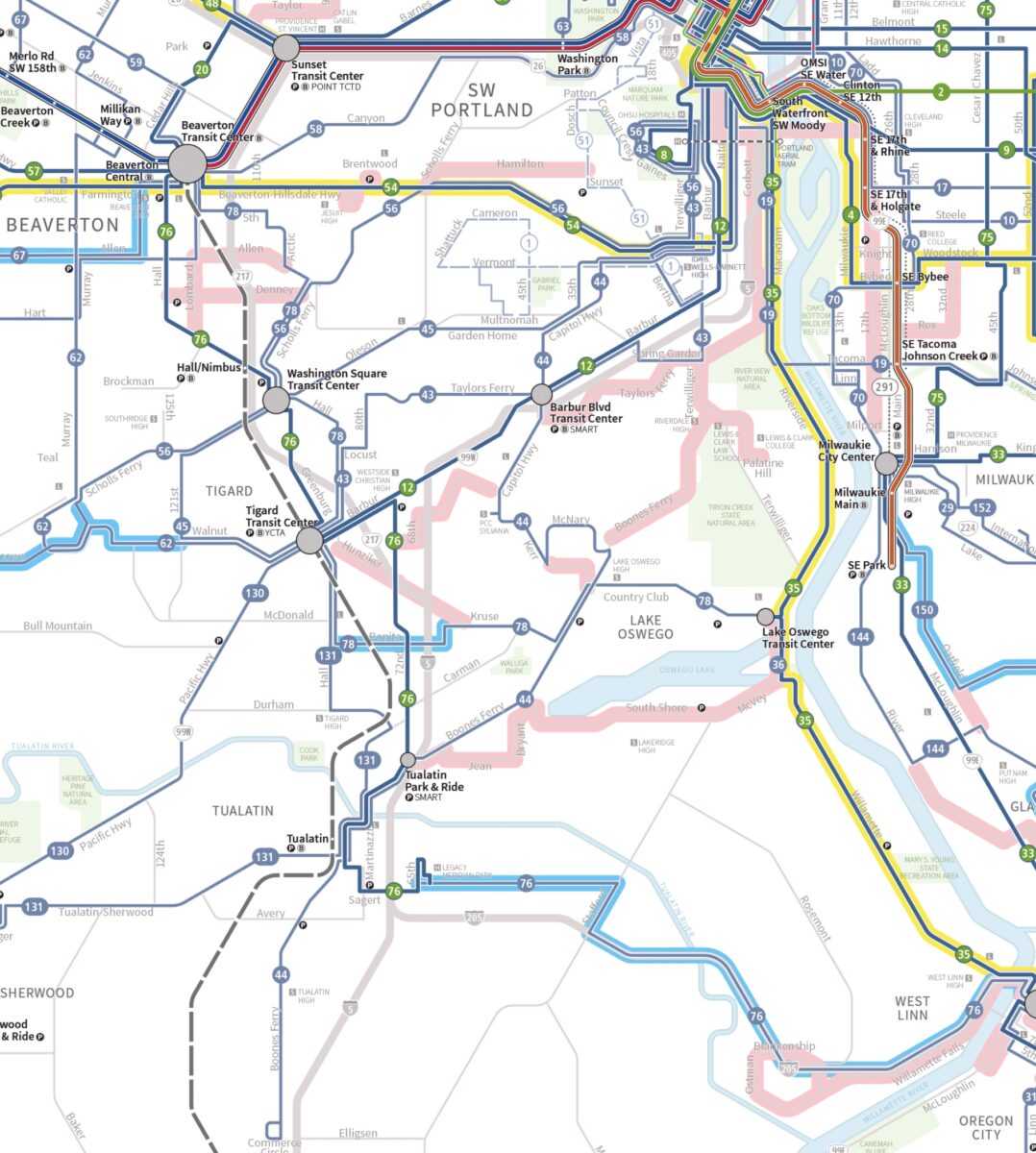TriMet has released its Forward Together Draft Service Concept (DSC) based in part on community responses to a survey they released back in March. TriMet says people want the transit agency to “focus on ridership and improving connections to destinations for people with low and limited incomes.”
While the Forward Together service concept includes changes throughout the network, there are a few ‘big ideas’ that impact every area, which include:
- Expanding access to opportunity by “making the transit system more useful for reaching jobs and major destinations like college campuses, grocery stores and hospitals, particularly for people traveling from areas with more lower-income residents.”
- More Frequent Service – TriMet plans to extend bus lines that run every 15 minutes to “reach more people and places,” including important corridors like Cornell Rd in Washington County, Woodstock Blvd in Southeast Portland, NE Halsey in East Portland and Gresham, and 82nd Drive in Clackamas County.
- New Eastside and Washington County grids to make it easier to travel east-west and north-south in these areas.
- Better regional links to job centers like Marquam Hill, Airport Way, Troutdale Reynolds Industrial Park, Columbia Blvd, and the North Hillsboro Industrial District.
- Expanded weekend service, especially to accommodate workers in retail, service and industrial sectors.
- New lines serving areas far from transit today, like like 148th Ave in Portland and Cornelius Pass Rd in Washington County.
According to TriMet, the proposed Forward Together bus service concept would “bring bus service to 50,000 more people, weekend service to 100,000 more and significant increases to frequent buses service to connect people and jobs.”
TriMet says they might be able to expand service by more than 30% in the next few years. But they acknowledge a major hurdle the agency will have to overcome first: their bus operator shortage, which has resulted in several bus lines eliminated from TriMet service this fall. If TriMet can’t hire more bus drivers, it won’t be possible to expand service.
There are a lot of changes encompassed in this concept – almost every bus line in the TriMet’s current roster will be impacted. 25 lines will be discontinued for low ridership or redundant service, and other buses rerouted to accommodate that service loss. Several routes will be upgraded to frequent service, which means they’ll come every 15 minutes instead of every 30 or 60. TriMet has also put forth ideas for more than a dozen new lines to make up for the canceled routes and cover new service areas.
There will be quite a few changes to bus service within inner Portland, but the big focus here is to expand public transit access throughout the farther reaches of the city and the metro area at large. Here are a few big takeaways I gleaned from looking at the concept and hearing the buzz from TriMet aficionados online.
The railroad track dilemma

TriMet has been met with criticism for routing its new Division FX service across the rail line at SE 11th/12th Ave in between Division and Powell, an area frequently clogged by car traffic because of stalled freight trains coming through the area. This has already begun to impact passengers using the closest thing Portland has to “bus rapid transit” service. The new service concept doesn’t address this concern, but it does outline a potential change to another line currently impacted by the train crossing.
If this concept were to come to fruition, Line 70 (12th to NE 33rd) would be rerouted away from the rail crossing at SE 11th/12th avenues. The bus would go southbound from 11th/12th and Hawthorne to proceed south along Ladd before heading east on Division, south on 26th, west on Bybee and south on 13th through Sellwood (and vice versa northbound). All Line 70 service would be moved from 17th to 13th in Sellwood.
East Portland
TriMet wants to create a more connected grid system in east Portland, where there are currently some large gaps that are especially prevalent in lower-income neighborhoods and for communities of color.
“The service concept makes a big investment in historically underserved east Portland, an area of rapid growth and large concentrations of low-income and minority residents,” the DSC states. There is a high percentage of transit users in east Portland, and more investment is necessary to make sure its growing population has access to quality service.
The concept focuses on adding north-south connections in east Portland, which are currently lacking. This would include new lines on 112th and 148th Avenues. TriMet also wants to include new connections north of Burnside and proposes upgrading Line 77 (Broadway/Halsey) to frequent service.
Through this concept, TriMet would also extend Line 4 south to take over SE Woodstock at the end of Line 19. This provides a connection to Lents and the green line MAX stop.
North and northeast


Inner northeast Portland would benefit from the frequent service on Line 77 on Broadway/Halsey. But the big changes across the area will be further north.
The DSC includes a new bus route, Line 190 on Columbia Blvd, to add service from north Portland to the Parkrose/Sumner MAX stop near the PDX Airport. This would serve people across the entirety of far north and northeast Portland, including in the Cully neighborhood, an area TriMet wanted to focus on. It also includes a frequent service line in the Cully neighborhood on Line 71 (60th Ave).
Southwest
— Written by Lisa Caballero
The bulk of the pink “service loss” routes are on the west side. Additionally, a couple of low-service lines which serve riders heading to Lincoln High School will be reduced to operating only during school commute times.
Of SW Portland it states,
SW Portland includes many large areas of very low density and high incomes. These areas are not a priority for service given their low ridership potential and the need to focus on equity.
That is the frankest statement TriMet has made about their plans for low-density swaths of the SW Portland since service cuts began in 2007.
However, the Draft Service Concept goes on to outline a strategy for increasing service frequency to the large employment center at the OHSU/VA complex on Marquam Hill, and also the “high ridership potential” of SW Portland’s major corridors.
Hillsdale and the Beaverton-Hillsdale Hwy take center stage, with the extension of frequent service all the way to Beaverton, and an increase of frequency along Capitol Hwy. This aligns well with PBOT’s recent Rose Lane installation, and their traffic calming and infrastructure projects throughout the area.
And if you look closely, there is also some good news for at least one rush-hour only line. The 51 has always run from downtown up to Portland Heights, stopped in the middle of nowhere on the other side of the hill, and returned—kind of like a yo-yo, it never went anywhere. The Service Concept proposes the line continue to Hillsdale, gaining an outbound end-point and destination for the first time ever. This is a small tweak with an outsized impact. It means that riders along this line can transfer at Hillsdale for high-frequency service west, rather than having to go northeast to downtown to make a transfer, and then retracing 270 degrees around the hill before the journey west even begins.
Beaverton and Hillsboro
Like in east Portland, TriMet wants to achieve a continuous grid of frequent service in the Portland region’s westside. Some notable examples of this are in Beaverton and Hillsboro. The draft concept includes five new lines in Beaverton and Hillsboro to build out the east-west/north-south connections. It would also make service more frequent on two popular routes – 52 (Farmington/185th) and 48 (Cornell).
TriMet user and outspoken public transit devotee Ben Fryback, who grew up in Tanasbourne in between Beaverton and Hillsboro, is particularly excited about having more frequent service on line 48.
“Since Line 48 only runs every 65 minutes on the weekends, having reliable transit was always a struggle. At one point, I commuted by bus from Tanasbourne to a place on TV Highway, and the 5 mile trip took over an hour. It was faster to ride my bike,” Fryback told me in a message. “The service increases in this area and in other places on the westside have the power to truly transform people’s lives.”
This is only a small selection of what’s included in the concept – there’s a lot more to look at, so check it out here. And remember, this isn’t final at all.
“It is not a proposal and certainly not a recommendation. We are not attached to it. Its purpose is to start a conversation by giving people something to react to. It *will* change, maybe a lot, based on public feedback,” Transit consultant Jarrett Walker (whose agency worked with TriMet on this project) said on Twitter. “Because it will change based on feedback, we need to hear what you like as well as what you don’t like. If you don’t tell us you like something, the thing you like might change!”
That survey is available here.







